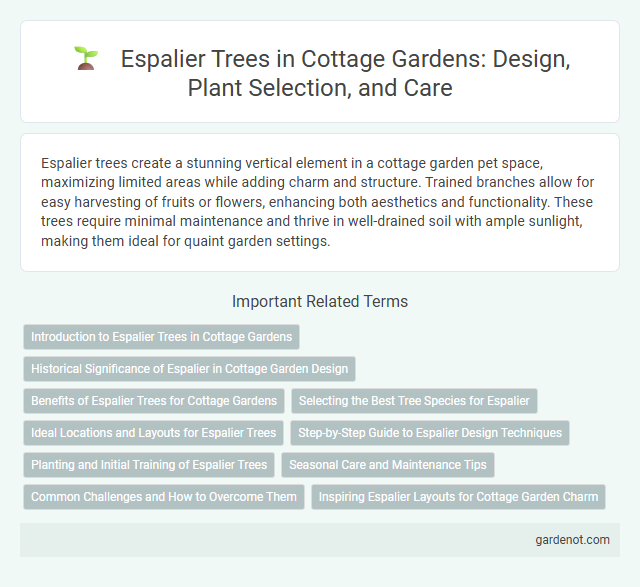Espalier trees create a stunning vertical element in a cottage garden pet space, maximizing limited areas while adding charm and structure. Trained branches allow for easy harvesting of fruits or flowers, enhancing both aesthetics and functionality. These trees require minimal maintenance and thrive in well-drained soil with ample sunlight, making them ideal for quaint garden settings.
Introduction to Espalier Trees in Cottage Gardens
Espalier trees, commonly found in cottage gardens, are cultivated through a specialized pruning technique that trains branches to grow flat against a wall or trellis, optimizing space and enhancing aesthetic appeal. This method not only maximizes sunlight exposure for better fruit production but also creates charming, structured patterns that complement the informal, lush character of cottage garden design. Popular espalier species in cottage gardens include apple, pear, and quince trees, chosen for their manageable growth habits and ornamental value.
Historical Significance of Espalier in Cottage Garden Design
Espalier trees hold a rich historical significance in cottage garden design, dating back to Renaissance Europe when they were used to maximize limited space by training fruit trees against walls and fences. Their strategic placement not only enhanced aesthetic appeal but also improved fruit production and microclimates within the garden. This technique reflects a centuries-old tradition of combining practical horticulture with decorative art to create charming, productive outdoor spaces.
Benefits of Espalier Trees for Cottage Gardens
Espalier trees maximize space efficiency in cottage gardens by growing flat against walls or fences, creating living green art while improving air circulation and sunlight exposure for surrounding plants. These trees enhance aesthetic appeal with their structured, decorative form, contributing to the garden's charm without overwhelming limited areas. Their fruit production in a compact design offers fresh, homegrown harvests, combining beauty and utility in cottage garden settings.
Selecting the Best Tree Species for Espalier
Choosing the best tree species for espalier in a cottage garden involves selecting varieties with flexible branches and a compact growth habit, such as apple (Malus domestica), pear (Pyrus communis), and cherry (Prunus avium). These species thrive when trained against a wall or fence, providing both ornamental appeal and fruit production. Opting for disease-resistant cultivars enhances longevity and reduces maintenance in the garden setting.
Ideal Locations and Layouts for Espalier Trees
Espalier trees thrive best against south-facing walls or fences where they receive ample sunlight and warmth, promoting healthy growth and fruit production. Incorporating espalier trees into narrow garden spaces or along walkways maximizes space efficiency while creating vertical interest and structure within the cottage garden. Proper spacing between trees, typically 2 to 3 feet, ensures adequate airflow and access for pruning and maintenance, optimizing both aesthetics and plant health.
Step-by-Step Guide to Espalier Design Techniques
Espalier design techniques for a cottage garden involve training fruit trees or ornamental species against a flat surface using careful pruning and tying branches to supports. Begin by selecting a young, flexible tree such as apple or pear, then establish a strong central trunk and guide horizontal branches evenly spaced along supports. Regular maintenance includes trimming new growth to maintain the desired shape and encouraging fruit production while enhancing the garden's aesthetic appeal.
Planting and Initial Training of Espalier Trees
Planting espalier trees requires selecting a sunny, well-drained site with fertile soil to ensure vigorous growth. Position the tree close to a sturdy support structure such as a trellis or wall to guide the branches during the initial training phase. Early pruning encourages horizontal branch development, shaping the tree into the desired two-dimensional form typical of espalier designs.
Seasonal Care and Maintenance Tips
Espalier trees in a cottage garden require regular pruning during the dormant season to maintain their flat, decorative shape and promote healthy growth. Consistent watering is essential in spring and summer, especially during dry spells, while mulch helps retain moisture and suppress weeds. Fertilize with a balanced, slow-release formula in early spring to support flowering and fruit development throughout the growing season.
Common Challenges and How to Overcome Them
Espalier trees in cottage gardens often face challenges such as pest infestations, fungal diseases, and improper pruning that can hinder their growth and shape. Managing these issues requires regular inspection for pests like aphids and scale insects, applying organic pesticides, and ensuring proper air circulation to prevent fungal infections such as powdery mildew. Consistent, precise pruning techniques help maintain the tree's flat form and promote healthy development, ensuring a thriving espalier display.
Inspiring Espalier Layouts for Cottage Garden Charm
Espalier trees create stunning vertical accents that maximize space in cottage gardens, offering a blend of practicality and aesthetic charm. Popular layouts include fan shapes, candelabra forms, and symmetrical tiers, each enhancing the garden's nostalgic, handcrafted feel while supporting healthy fruit growth. Choosing espalier patterns that echo traditional cottage designs not only boosts visual interest but also invites wildlife, creating a vibrant, productive garden ecosystem.
Espalier tree Infographic

 gardenot.com
gardenot.com